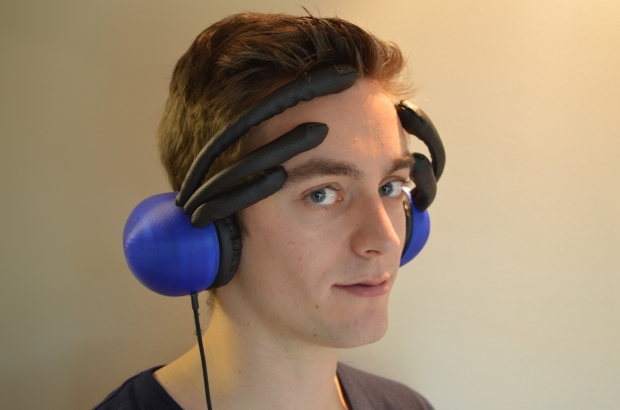- Daily & Weekly newsletters
- Buy & download The Bulletin
- Comment on our articles
Belgian students develop headphones that read your mind
As part of a Ghent University (UGent) course that aims to bring together tomorrow’ designers with tomorrow’s engineers, three students have designed a headphone that selects and plays music based on users’ brain activity.
A headphone with three tentacles that jut out from both sides, Emuse (pictured) looks like a futuristic space helmet. The tentacles read and interpret the wearers’ brainwaves to determine their state of mind and then selects music that complements it.
“Our assignment was to do something with a neuro headset that measures brain activity and thereby controls a certain object,” explains Francis Foubert, a student in industrial design who developed the headphone together with fellow students Alicia Teerlinck and Kenny Nuyten. “In our brainstorming sessions, we came up with the idea to do something with music and emotions.”
They designed the headphone to measure brain activity and compare the brain’s left and right half. That information is then placed on a scale from positive to negative values, and from active to passive. Based on that information, Emuse selects music from the user’s music library.
Working prototype
The problem, the students realised, was that users may not necessarily want to hear sad music when feeling blue. “That’s why Emuse also remembers what you skip in a certain mood,” says Foubert. “It is a learning system that gets to know you better and better.”
Given the success of digital musical services like Spotify that allow users to curate their own playing lists and libraries, a gadget like this seems likely to attract consumer interest. Yet Emuse won’t be hitting stores any time soon, says Foubert. “We have been working on the system for three months. What we have now is a working prototype. But it is still far from finished.”
Students in the UGent mechatronic product design course have also created other mind-boggling devices. How about the desk lamp that follows users’ movements for optimal lighting? Or the bicycle light that reacts to traffic, or the Whack-A-Mouse, which dares cats to hit a toy mouse that occasionally pokes its head out.
Another, more serious, design is Current Stories, created for the Dr Guislain Museum in Ghent. Through speaking and listening houseplants, this installation offers visitors the opportunity to share their impressions after a visit to one of the museum’s psychiatrically inspired exhibitions.
The plants are suspended from the ceiling and are equipped with sensors that record the impressions of visitors and narrate them to other visitors. The system is activated when you touch the plants.
“Smart products”
The course from which all these designs emerged, Mechatronic Product Design and Embedded Prototyping, is an interdisciplinary programme that pairs design with electronic engineering students.
The aim is to integrate electronics into product design, explains Jelle Saldien, one of the professors who teaches the course. “We want to design smart products that enable interaction, something that will be increasingly important in the future.
”The course’s strength is its cross-discipline approach, he says, which makes it possible to not only conceptualise potential products but also to actually create them. According to Saldien, the course is organised very intuitively.
“We aim to create an open environment for students where they are free to experiment – a kind of sandbox culture where they can be creative and must be allowed to fail,” he says. “They are given deliberately vague assignments – some by us teachers, some by businesses.”
The students’ assignments can range from making time more tangible to developing an intelligent application for bicycles. “We see that this approach works; each year the students achieve particularly strong results.”
Photo courtesy UGent









